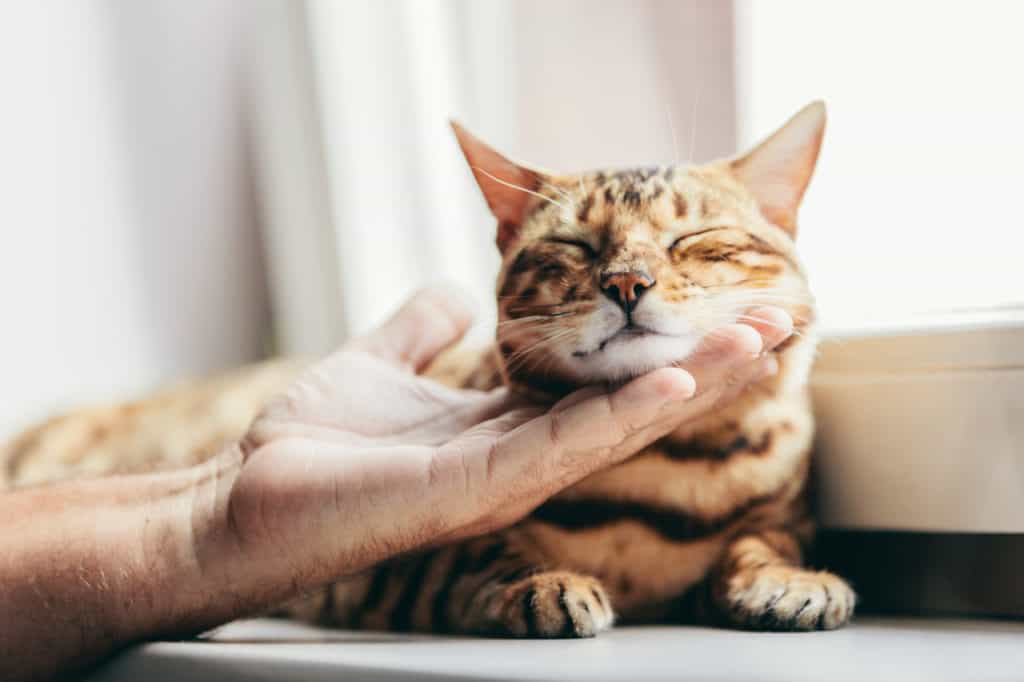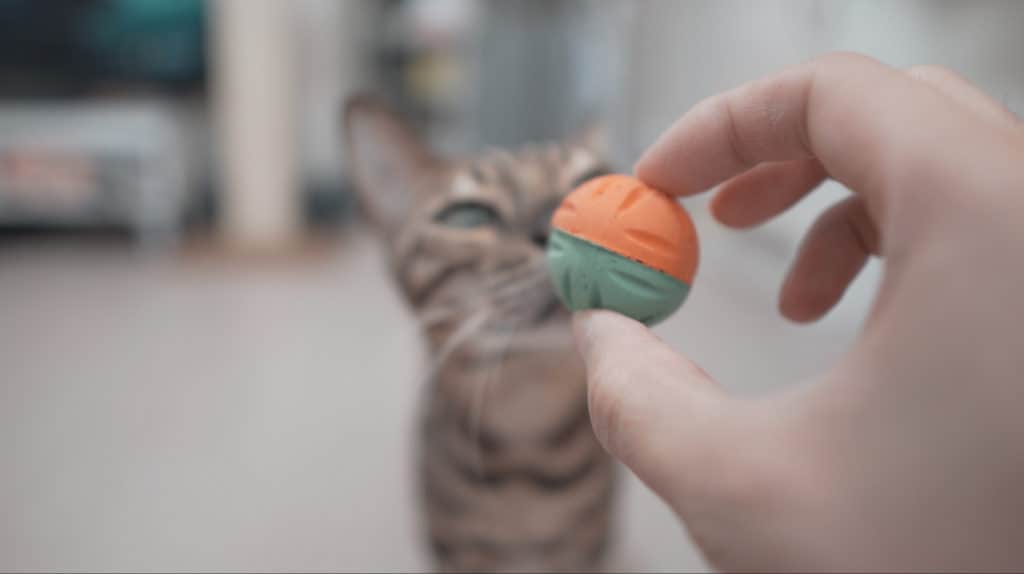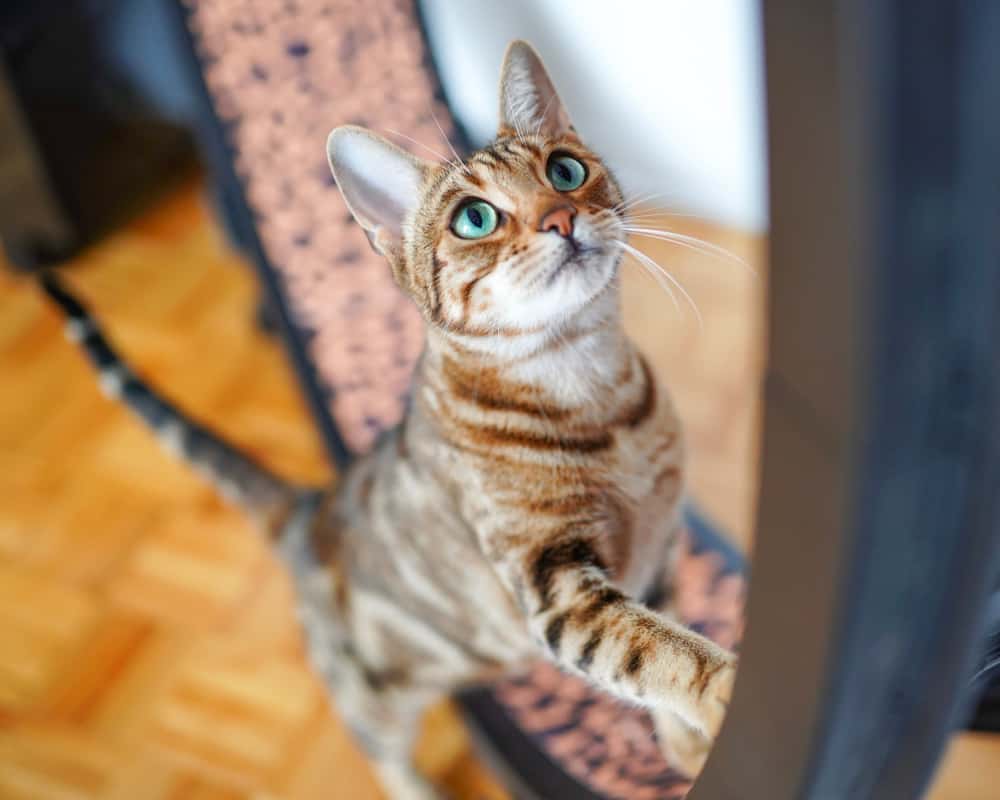I write a lot of content on Bengal cats. First, I love the Bengal breed. Also, I dealt with my Bengal kitten in a small studio apartment with two other cats and managed to keep my sanity.
So I figured someone else is out there like me interested in the breed but might be worried about how crazy they are. This article is for you and trust me. It’s a lot more manageable than you think!

So how do you Bengal-proof an apartment or house? To Bengal proof a home, provide your Bengal with proper environment stimulation (places to perch, climb, and scratch), utilize play therapy (meaningful playtime), and prepare for their quirks to prevent them from developing bad habits.
Why Bengal Proof a Home?
Bengal cats are just not cats with leopard patterns. They have a much higher energy state than many other cats and require a lot of attention. Therefore, they’re much more prone to developing bad behavioral traits.
I remember seeing many online posts looking for people to adopt/foster abandoned Bengal cats. At that time, I found it strange that anybody would throw out such a special cat. However, as I experienced what it meant to own a Bengal cat, I didn’t know it would be full of surprises. Unfortunately for the people who aren’t prepared for it, these surprises can be overwhelming, leading to, unfortunately, events such as this.
Bengals are intelligent and active. They are proactive cats that want to invoke reactions and a response from their owners or whatever it is that they’re interacting with. As a result, they can be quite the handful.
Common Bengal Habits in an Apartment or House
These habits are not negative or bad per se but depending on the situation, they can develop into more destructive habits. These include some of the Bengal cat’s quirks, and some of these habits are things that housecats do too, but Bengal cats display them on a more frequent basis.

- Biting – All cats bite but it seems that Bengal cats bite quite a bit as kittens. This can include biting their butlers, cables, or plastic or whatever is around at the time.
- Scratching – They also love to use their claws. Having the proper outlet to use their claws is the key to having relatively clean furniture!
- Burrowing – Bengal cats love to go under covers, blankets, or clothes. They can quickly and quietly get under loose mats too! So it’s important to watch where you step! The more difficult thing is when they burrow inside places that they can’t get out of and cry for help!
- Wet paws – they love the sound of water so before they take a drink they might poke it at a couple of times and so it might cause some wet paw prints around!
- Chirps, meows, and chatter – Bengal cats are talkative, they have a sound for whatever they’re feeling. Sometimes they’re making a sound for attention, so it’s important to know when to give them that attention and when to ignore them.
How to Bengal Proof a Home
1. Provide Proper Things for Bengal Cats to Bite & Scratch Safely
If a Bengal cat is doing some unwanted scratching on your furniture or biting stuff that it shouldn’t be, that means there aren’t any other better alternatives to do it on. Young Bengal kittens are often practicing their hunting skills and express themselves through biting and scratching.
Provide the things for them to bite and scratch safely without damaging your belongings.

If your Bengal cat is biting unwanted objects, first, what is it that they are biting? If they prefer particular objects or shapes, get them a bite-able version of that thing. For example, Latte, my Bengal, enjoys chewing things that are stick-like (router antennas, pencils, etc.), so if he displays these behaviors often enough, I’ll take out Matatabi sticks (basically just a wooden stick for cats to bite). It has the effect of catnip in the form of a stick. Cats can bite it and scratch it safely to release that instinct.
If your Bengal cat scratches something that it isn’t supposed to, provide them with something even better to scratch. Usually, cats will scratch the object that is most stable and has good resistance to their claws. A sturdy scratching post that is high and allows them to stretch out their body in most cases will solve scratching issues in a home!
If no other object or furniture in the house provides Bengal’s needs, they will naturally try to look for something else to scratch.
2. Keep Valuables in High Places to Keep Your Items Safe From Bengal Cats
As a general rule, anything below your waist is fair play for Bengal. If it’s able to open, they’ll figure out a way in.
In general, their burrowing habits are harmless. They love to get warm by burrowing under blankets and mats. It’s cute until they find their way into the snack cabinet or cupboard and drag everything out. Bengals are notorious for opening cabinets and drawers. High cabinets and drawers are more difficult to open because they can’t use their body weight to open them. If you have anything valuable, put it up high.
If I have snacks or anything valuable that I want to keep away from my Bengal cat, package it up in an airtight bag and put it in an overhead cupboard or cabinet. Again, provide an alternative such as a box or tunnel for a safe place for your Bengal cat to explore. Giving them a variety of different cat-centric areas keeps their crazy explorations at bay.
3. Secure & Seal Food/Snacks
Bengal cats are like domesticated cats but on steroids. Their persistence is on another level. Regular cats will smell something but won’t try much to retrieve whatever it is. Bengals, however, will go and try their gosh darn best to get it. However much force is needed, they will use it.
I have a food container that I tape shut, or else Latte (my Bengal cat) comes on over, lifts the lever with his head, and digs out the food. I’ve watched him do it. However, because I want them to eat on a set schedule, I can’t have him open the food dispenser box whenever he wants. As a result, I taped it shut (Lately, though, he discovered that he could rip the tape and then dig out the food).
Anyways because of this, if they do start getting into things and playing with stuff that you don’t want them to, make sure it’s put away securely in a high spot. If it isn’t possible to put it in a high place, then tape the cupboard shut. There are also safety latches for cabinets. A little bit of tape goes a long way, especially if I’m going to be out of the house for more extended periods.
4. A Bored Bengal is a Destructive One
When I say destructive behavior, I mean knocking things over, taking things out or apart, or maybe bothering other cats or animals in the house with overly rough play. Part of Bengal proofing a home is noticing when your Bengal cat gets bored.

Again, Bengal cats are incredibly active and intelligent. They get bored pretty quickly. There are times when they get hyperactive and when you see any of the above things happening, take it as a sign that they need more playtime. See my article on how to play with your cat and play routine!
It doesn’t matter if it’s a Bengal cat or not. All cats benefit from playtime. The more you play, the more you’ll find that your cat’s personality is going to mellow out.
How to Deal with Bengal Cat Quirks?
You might have already heard that the breed loves water and are quite talkative. This is mostly true.
Bengal cats enjoy running water in varying amounts. A water fountain does wonders for their entertainment as well as provides them with much-needed hydration! Some Bengal cats love a shower to get completely wet, and some would instead bat at running water with their paws rather than get wet themselves.
As such, they tend to walk around with wet paws pretty often, or you’ll find some puddles on the floor because they have been smacking the water fountain. For the most part, it’s pretty harmless, and the only thing you should be concerned about is the water fountain placement. Make sure it’s far away from anything that shouldn’t get wet such as power outlets.

Bengal cats are very talkative. They’ll chirp when they’re hunting or greeting you, whine when bored, and meow quite loudly when they want something. It’s something that you’ll find charming or annoying. Or sometimes both at the same time.
There’s no way to keep them quiet, but you can ensure that they don’t keep doing it by not reacting to their sounds. If you give them attention during their calls, they’ll learn that you’ll respond if they make that call. So be careful about which sound or noise you react to when interacting with your Bengal cat!
Bengal Proof Home: Conclusion
In conclusion, cat butlers should need some education and preparation before considering adopting or owning a Bengal cat.
Like most experiences, however, the things that take a bit more effort to prepare for always make the most impact on our lives! My Bengal has taught me a lot of things about myself and animals. So it has been an enriching journey.

HELP! I have an 8 month old who is the most tenacious persistent cat I’ve ever seen. I had 2 bengals before that lived to 17 and 18 years. They were mellow in comparison. This one is making me lose my mind. Even tries to get to the top of my paintings on the walls. Just today tried to get inside a heating vent with a loose grill. I locked him away to try to get some screws into the vent. When I let him out 40 minutes later, he made a beeline for the vent as fast as he could.
He has my corgi to play with and they wrestle constantly but he opens doors, tries to lift lids, breaks into my dog’s covered dog food can…
I’ve never given up on an animal but this one is very trying. I literally have to brush my teeth over his back.
How do I discipline him? Last night he got caught under my China cabinet which is so heavy I couldn’t move it an inch. I thought I’d have to call the fire department. As soon as he came out and I went to grab him, he made a duce to go back behind the China cabinet. He’s too much! Help!
It’s either a case of boredom or a case of excess energy. I’d take the time to think about your space to add more things he can explore and get into that are safe and expends energy naturally! Thanks for your comment!